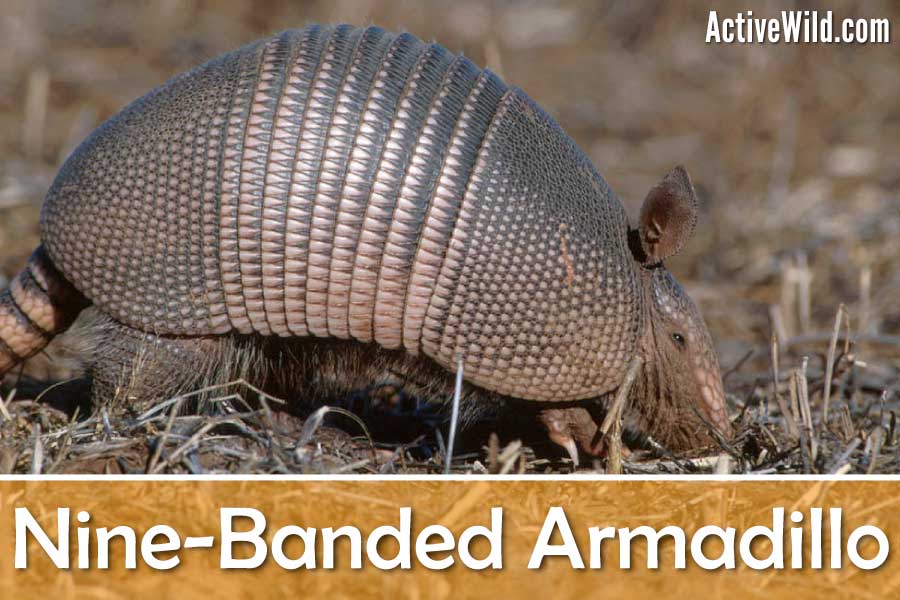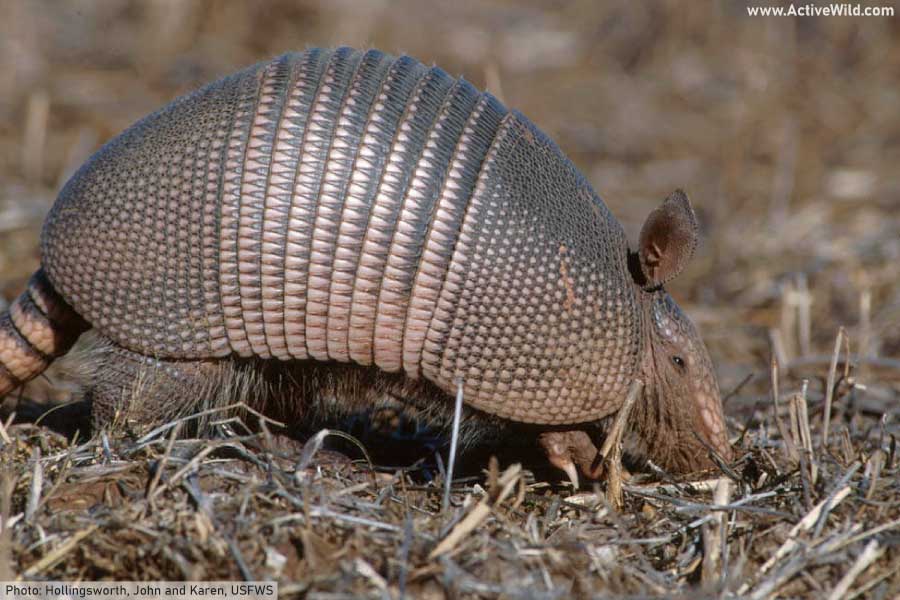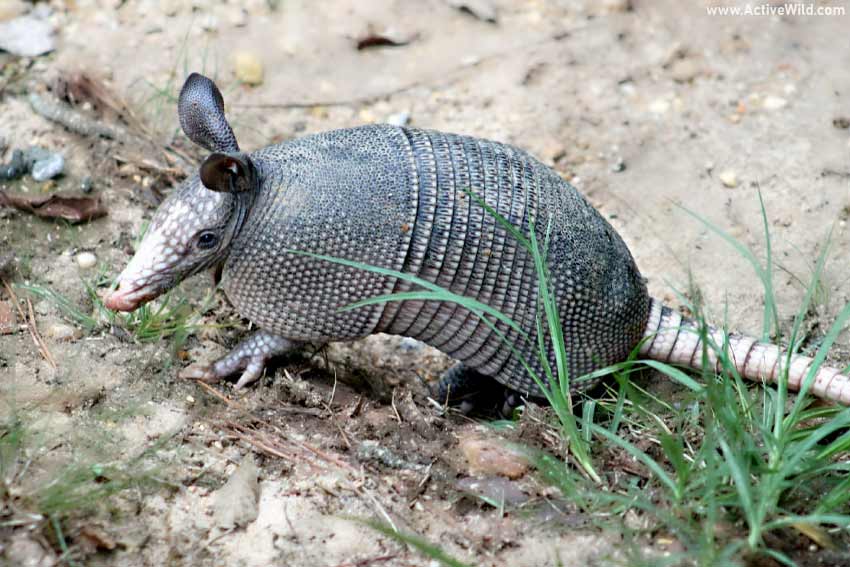The nine-banded armadillo Dasypus novemcinctus is a mid-sized burrowing mammal with flexible, bone-plated armor covering its head, back and tail. The species, one of 21 living armadillos, is found in South, Central, and southern North America, and is the only armadillo regularly found in the USA.
Read on for nine-banded armadillo facts, pictures and in-depth information…
Nine-Banded Armadillo Facts: Page Index
- Nine-Banded Armadillo Facts At A Glance
- Introduction
- Where Is The Nine-Banded Armadillo Found?
- How Big Is A Nine-Banded Armadillo?
- Anatomy
- Nine-Banded Armadillo Diet
- Nine-Banded Armadillo Behavior and Life Cycle
- Nine-Banded Armadillo Predators
- Nine-Banded Armadillo Family And Related Animals
- Prehistoric Armadillos
- Armadillo Vs Pangolin
- Nine-Banded Armadillo Habitat
- Nine-banded Armadillos And Humans
- Are Nine-Banded Armadillos Endangered?
- Further Reading And References
Nine-Banded Armadillo Facts At A Glance
- Scientific name: Dasypus novemcinctus
- Type of Animal: The nine-banded armadillo is a mammal in the Order Cingulata. This order, which contains all 21 living armadillos, is part of the superorder Xenarthra, a group of mainly South American animals that also includes sloths and anteaters.
- Animal Family: Dasypodidae
- Where Found: South, Central, and southern North America
- Length: Around 2.5 ft. (76 cm)
- Weight: Around 12 lb. (5.5 kg)
- Conservation Status: Least Concern
Introduction
The nine-banded armadillo is a squat animal with short but powerful legs and a round body covered in heavy bony plates. It has a long snout, small eyes, large ears, and a long, tail, which is also armored.
Although the armadillo has a scaly, almost reptilian appearance, it’s actually a mammal: it has hair, is warm-blooded, and females nurse their young with milk.
- You can find out more about mammal characteristics on this page: Mammal Facts
Where Is The Nine-Banded Armadillo Found?
Armadillos are only found in the Americas, with most of the 21 living armadillo species being found in South and Central America.
The nine-banded armadillo is found across a wider range, and further north, than any other armadillo. Its range extends from Argentina and Uruguay in the south, to the southeastern United States in the north.
The species has been expanding the northernmost limits of its range for over 100 years. As of 2015, nine-banded armadillos had been recorded as far north as Nebraska, Illinois and Indiana; models project that the species' range could eventually reach well into New England. However, because the nine-banded armadillo does not hibernate, it's likely that the cold winters of the northern United States will hinder its progress any further north.
How Big Is A Nine-Banded Armadillo?
The nine-banded armadillo is one of the largest armadillos, with a nose to tail length of around 28-40 inches (71 to 101 cm). It weighs from 5 to 20 lbs. (2.5 to 9 kg).
Anatomy
The armadillo’s armor is made up of bony scales that are joined with hard skin to make a flexible, shell-like covering.
The characteristic bands in the armadillo’s armor make it more flexible, just like the plates in a medieval suit of armor.
Despite the name, nine-banded armadillos don’t always have nine bands: the actual number can be anywhere from 7 to 11.
At a glance, nine-banded armadillos appear hairless. But a closer look reveals a scraggly layer of hair running from the chin down to the belly, plus little tufts poking out between the armor plates. Other armadillo species vary in their hair pattern.
The nine-banded armadillo has tiny, almost useless eyes. Like all armadillos, nine-banded armadillos are monochromats, meaning they can’t see in color. In fact, an armadillo’s color vision is actually among the worst of all vertebrates.
Even dogs, which are famously supposed to be “colorblind,” actually do have some color vision. A dog’s eyes contain cones (the eye cells that enable color vision); it’s just that their cone cells aren’t sensitive to as many colors as ours.
Armadillos, on the other hand, don’t have cone cells at all, meaning they completely lack color vision.
Nine-Banded Armadillo Diet
Armadillos find food by digging in the soil. Armadillos are primarily insectivorous (insect-eating). They’re particularly fond of grubs (the worm-like larvae of some insects), which are densely-packed with nutrients and easy to digest.
Grubs can be a lot of work to obtain because they live underground, but once captured they’re an ideal food source. Armadillos also eat worms, termites, and occasionally plants or fungi.
Nine-Banded Armadillo Behavior and Life Cycle
Digging
The nine-banded armadillo is built for digging. Its shovel-like front paws and long, powerful claws are efficient tools for excavating the burrows in which the animals live and reproduce.
A single armadillo may dig multiple burrows. Armadillo burrows that have been abandoned by their original owner often become homes for reptiles or other mammals.
Swimming
The nine-banded armadillo looks heavy and ungainly, so it’s surprising to learn that it’s actually a fairly strong swimmer.
The species can cross streams either by swimming or by sinking to the bottom and walking underwater. The species is able to hold its breath for up to six minutes; perhaps an adaptation for foraging in the soil.
Social Activity
Nine-banded armadillos are solitary animals; each burrow typically contains either a single adult or a female with her young.
The species doesn’t form social groups or long-term pairs. After reaching adulthood, a nine-banded armadillo may never interact with another armadillo outside of the breeding season, which occurs during the summer.
Male nine-banded armadillos are territorial. During the breeding season, they fight to prevent other males from entering their territory so that they can mate exclusively with any females who live there.
Once it has established a territory, an individual male can mate with as many as three females. Females, on the other hand, may travel between territories to mate with more than one male.
The following spring, the female will give birth to four identical quadruplets, all of which have developed from a single fertilized egg.
This is an extremely unusual system called “monozygotic polyembryony,” meaning basically that the zygote (fertilized egg) splits into four embryos at an early stage of development.
Nine-Banded Armadillo Predators
The armadillo’s thick armor makes it a difficult meal for predators. However, with enough hard work, some predators can break through the armadillo’s protection.
Predators of the nine-banded armadillo include the mountain lion, bobcat, maned wolf and coyote.
Wolves would be a potential threat as well, but humans have largely eliminated wolves from the armadillo’s habitat.
Smaller predators, like foxes, raccoons and raptors are more likely to prey on young armadillos.
Unlike some armadillos, the nine-band armadillo doesn’t curl into a ball when threatened.
Although its armor may help slow down a predator or thwart a surprise attack, the nine-banded armadillo doesn’t rely on it completely in the way other armadillos do. Instead, it will attempt to escape, either by leaping, fleeing, or burrowing.
Despite its squat, short-legged appearance, the armadillo can jump several times its own height when startled.
Nine-Banded Armadillo Lifespan
No one knows exactly how long a nine-banded armadillo can live in the wild. In captivity, they live to about 15 years maximum, but a few individuals have been reported to live much longer.
Nine-banded armadillos are mostly nocturnal. Because armadillos are nearly blind, they don’t need sunlight to get around, so there’s not much advantage in being out during the day.
The exception is in cold weather: when the nights are especially chilly, armadillos will take advantage of the sun’s warmth and become more diurnal (day-active).
Nine-Banded Armadillo Family And Related Animals
Armadillos belong to the order Xenarthra, a collection of odd-looking mammals including sloths and anteaters.
Xenarthra means “strange joints,” and it’s true: the skeletons of xenarthrans are unusual among mammals, especially in the limbs and spine. You can sort of tell just by looking: the hands and feet of armadillos, sloths, and anteaters all have a distinctive claw-like shape.
Armadillos and anteaters use their strange hands for digging, whereas sloths use them for climbing.
Xenarthrans’ closest relatives are the Afrotherians, a diverse group that includes elephants, manatees, and a bewildering array of small rodent-like animals.
The nine-banded armadillo is one of the largest armadillo species. The smallest is the pink fairy armadillo of Argentina. At only 3-4 inches, its whole body could fit comfortably in the palm of a child’s hand.
Prehistoric Armadillos
Today’s armadillos may be small, but their ancestors were tanks. The glyptodonts were a family of giant prehistoric armadillos that lived in South America during the Miocene and Pliocene. The largest grew as much as 13 feet long – the size of a small car.
Some glyptodont species even had bony clubs at the end of their long tails, making them look just like the mammalian equivalent of an Ankylosaurus.
Armadillo Vs Pangolin
Armadillos aren’t the only armored mammals: there’s also the pangolins, another group of burrowing insectivores.
Despite their similarities, pangolins aren’t related to armadillos. (The nearest relatives of pangolins are the Carnivorans – cats, dogs, bears, etc. In fact, a pangolin is more closely related to you than it is to an armadillo.)
Pangolin armor is quite different from armadillo armor. Instead of bony plates, pangolins have armored scales made from compressed hair, not unlike a rhinoceros horn.
The one place where pangolins have bony armor is the head: their skulls are unusually thick.
The pangolin and the armadillo are a great example of convergent evolution: two animals with similar ecological needs that evolve similar anatomical solutions. Despite starting off in totally different places on the tree of life, they end up looking very much alike.
Nine-Banded Armadillo Habitat
The nine-banded armadillo is an adaptable species able to live in a variety of habitats ranging from tropical rainforests to prairies.
The main constraint on nine-banded armadillo habitat isn’t rainfall or vegetation, but soil condition.
This is because the animal’s lifestyle is centered around digging. It can’t live in places in which it is unable to dig – for example, areas with tough, compacted soil or permafrost.
For the same reason, the nine-banded armadillo tends to be found near water, where digging is easier.
Although the nine-banded armadillo can live in all sorts of climates, it prefers habitats with some canopy cover. That’s because invertebrates are generally more abundant in forests and woodlands.
Nine-banded Armadillos And Humans
Armadillos occasionally dig up suburban flower gardens or vegetable patches, or make holes into which domestic animals can fall and injure themselves. For this reason, armadillos have a bad reputation among some homeowners.
For the most part, however, armadillos are harmless. They can even be beneficial to gardeners because they reduce populations of plant-eating grubs.
Are Nine-Banded Armadillos Endangered?
The nine-banded armadillo is adaptable, able to reproduce quickly, and seems to tolerate living near humans. The species is not threatened, and its IUCN conservation status is currently “Least Concern”.
In fact, the rapid expansion of the nine-banded armadillo’s range suggests that it is actually thriving.
Further Reading And References
Feng, X., and M. Papeş. "Ecological niche modelling confirms potential north‐east range expansion of the nine‐banded armadillo (Dasypus novemcinctus) in the USA." Journal of Biogeography 42.4 (2015): 803-807.
Chapman, J., G. Feldhamer. 1982. Wild Mammals of North America: Biology, Management, and Economics. John Hopkins University Press.
Emerling Christopher A. and Springer Mark S. 2015. Genomic evidence for rod monochromacy in sloths and armadillos suggests early subterranean history for Xenarthra. Proc. R. Soc. B.









I have seen more than a few armadillos after they met their demise on the side of the road :-(. I didn’t know before that they had poor vision. That might explain why they get hit on the road. The pangolin looks quite interesting too.
I loved the part about how although pangolins look a bit like an armadillo, they are not related.